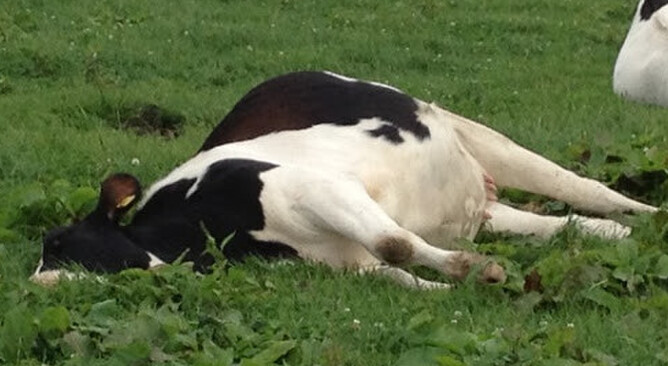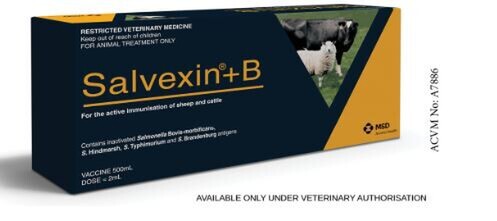A silent & costly killer in the South?
There are many species of Salmonella bacteria which affect many species of animals including humans. They are bacteria of the gut that are carried and spread by carrier animals, who usually carry infection without any symptoms, but shed enough bacteria to go on and infect other animals. These animals can shed bacteria through infected faeces and aborted material, which in turn can be spread by scavenging animals such as hawks, seagulls, mice and rats.
The disease itself is characterised classically by a khaki-green, foul smelling, diarrhoea, high temperatures, and death, but can also cause abortion and a drop in milk production. In sheep we see large outbreaks of abortions and death due to Salmonella Brandenburg regularly every year in July through September, and every few years in the Summer and Autumn we see outbreaks of Salmonella Hindmarsh. In cattle we had tended to see only sporadic cases of Salmonella but it appears to be occurring throughout the country in more and more ‘outbreak’ type scenarios.
Recent Salmonella Typhimurium Cases in the South
We documented 3 outbreaks of Salmonella Typhimurium on VetSouth farms between January and April 2020 in the wider Eastern Southland region.
Farm 1: Farm staff noticed 10 (under 1%) cows suddenly off their milk. From full production of 2 kgMS/d to nothing within a 48 hr period. When drafted out the cows ranged from looking perfectly fine in themselves, to hollow and scouring. A presumptive diagnosis was made of Salmonella on this basis, and the fact that some of the affected cows also had high temperatures. Vaccination with Salvexin+B over the whole herd was initiated immediately while a culture result from faeces was pending. Salmonella Typhimurium was confirmed.
In total 92 cows were treated and 6 cows died. 19 cows that were pregnant at the first scan had aborted at the re-check scan. Total cost of the outbreak is thought to exceed $60k ($10k treatments, $20k lost milk production, and $30k in animal losses).
Farm 2: Were aware of Salmonella in the district following hearing of the Farm 1 being affected. A presumptive diagnosis was made of Salmonella on a single cow (herd size 760 cows) being affected with sudden drop in milk, recumbency, and lots of cows in the herd with a smelly scour. There was not a noticeable drop in bulk milk tank yield, however the farmer describes the sudden drop in milk production of affected cows as dramatic - from over 2 kg MS/d to nothing within 24 - 48 hrs. Vaccination with Salvexin+B was implemented immediately. Faecal culture results confirmed Salmonella Typhimurium.
Overall 25 cows were treated and only 1 cow died. The estimated cost of the outbreak was over $15k.
Farm 3: Noticed over 5 days an increasing number of cows with a general look of being hollow in the gut, and then cows with a sudden drop in milk production. About 40 of these looked particularly ill on day 5, with some scouring and many having a high temperature. The herd was vaccinated on day 6 while faecal cultures waited to eventually confirm a diagnosis of Salmonella Typhimurium. In total 3 cows died, and there were 3 known abortions (a final dry off scan will be done shortly to confirm the total number of slips). 83 cows received antibiotic and anti-inflammatories in combination, with a further 71 cows with mild symptoms treated with anti-inflammatories alone, making a total of 154 cows affected or 15 % of the herd. This farm experienced a massive drop in milk production, which at its worst was equivalent to about 30% drop in total vat yield for 2 weeks. Production recovered somewhat, but it was estimated that the outbreak cost about 15,000 kgMS in total. A cost estimate for the outbreak was $16.5k of treatment costs, and around $115 k in lost milk production and cow deaths.
All of these farms were System 5 high input farms and all of them feeding a pellet that contained magnesium. All of these outbreaks were caught quite early resulting in low case mortality, although known morbidity ranged between 7 - 15 % of the herd.
Impact of Salmonella on farm
Outbreaks tend to escalate quickly. This is an infectious disease where each animal that is infected has the opportunity to spread the disease to others. Transmission is usually through the faecal-oral route, cows consuming feed contaminated by another's faeces. Some outbreaks have been reported to involve 30 - 50 % of the affected dairy herd. Costs include lost milk production, treatment, deaths, abortions and the cost of replacing empty or dead cows. The disease is zoonotic (can be passed from animals to humans) which makes it a risk to farm staff and consumers drinking contaminated milk.
Managing Salmonella
As always prevention is the best method, to protect your herd, your production and your bank balance. Salvexin-B is a Salmonella vaccine which is effective in both sheep and cattle. It has been a useful tool in both preventing outbreaks from occurring, and then reducing the severity of outbreaks when they occur. In most cases, the cost of a vaccine would be repaid if an outbreak happened about once every 15 - 20 years. For a large outbreak where 15% or more of the herd is affected, this would be repaid if an outbreak only occurs every 30 - 40 years.
Farm management techniques are also key prevention tools, so its timely to consider the following:
- Having a good pest control program around where supplement is stored and fed
- Cleaning feed troughs regularly
- Preventing cattle from defecating in the feed bins
- Reducing stress in the herd. Many diseases lie dormant until a stressful event occurs and shedding of bacteria or virus into the environment is increased
- Be aware of where potentially contaminated faeces is spread on the farm, and having vulnerable animals away from these areas
- Feeding of palm kernel extract can attract vermin which contaminate the meal with faeces and associated enteric bacteria. Presumably other supplements which attract vermin will carry a similar risk.
- Feeding from continuous troughs where animals have the opportunity to eat more than their allocation of contaminated feed can heighten the risk.
- Feeding of magnesium oxide (a base), particularly in granular or pelleted form can increase the pH of the rumen which favours growth of bacteria such as the Salmonella species. Because pellets can dissolve poorly they are thought to provide a “micro-environment” on which pathogens such as Salmonella can pass through the rumen and into the small intestine where disease occurs. In 2018 dairy cattle veterinarians were asked to report on any outbreaks of Salmonella across the country, and 23 cases were reported as a result. On average, 10% of cows were affected in each of the cases (an average of 70 cows per herd, average herd size of 695 cows). 87% of these herds were feeding a pelletised supplement containing magnesium.
- Joel Hughes


